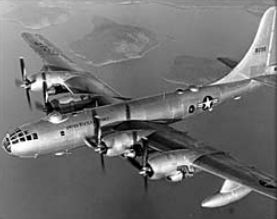B-50 Superfortress
| B-50 Superfortress | |
|---|---|
 |
|
| A Boeing B-50D | |
| Role | Strategic bomber |
| National origin | United States |
| Manufacturer | Boeing |
| First flight | 25 June 1947 |
| Introduction | 1948 |
| Retired | 1965 |
| Status | Retired |
| Primary user | United States Air Force |
| Produced | 1947–1953 |
| Number built | 370 |
| Unit cost |
US $1,144,296 ($11.4 million in today's dollars)
|
| Developed from | Boeing B-29 Superfortress |
| Variants | Boeing C-97 Stratofreighter |
The Boeing B-50 Superfortress is an American strategic bomber. A post–World War II revision of the Boeing B-29 Superfortress, it was fitted with more powerful Pratt & Whitney R-4360 radial engines, stronger structure, a taller tail fin, and other improvements. It was the last piston-engined bomber designed by Boeing for the United States Air Force (except the never-completed B-54, a derivative of the B-50). Not as well known as its direct predecessor, the B-50 was in USAF service for nearly 20 years.
After its primary service with SAC ended, B-50 airframes were modified into aerial tankers for Tactical Air Command (KB-50) and as weather reconnaissance aircraft (WB-50) for the Air Weather Service. Both the tanker and hurricane hunter versions were retired in March 1965 due to metal fatigue and corrosion found in the wreckage of KB-50J, 48-065, which crashed on 14 October 1964.
Development of an improved B-29 started in 1944, with the desire to replace the unreliable Wright R-3350 Duplex Cyclone engines with the more powerful four-row, 28-cylinder Pratt & Whitney R-4360 Wasp Major radial engine, America's largest-ever displacement aircraft piston engine in large-scale production. A B-29A-5-BN (serial number 42-93845) was modified by Pratt & Whitney as a testbed for the installation of the R-4360 in the B-29, with four 3,000 hp (2,200 kW) R-4360-33s replacing the 2,200 hp (1,600 kW) R-3350s. The modified aircraft, designated XB-44 Superfortress, first flew in May 1945. The planned Wasp-Major powered bomber, the B-29D, was to incorporate considerable changes in addition to the engine installation tested in the XB-44. The use of a new alloy of aluminum, 75-S rather than the existing 24ST, gave a wing that was both stronger and lighter, while the undercarriage was strengthened to allow the aircraft to operate at weights of up to 40,000 lb (18,000 kg) greater than the B-29. A larger vertical fin and rudder (which could fold to allow the aircraft to fit into existing hangars) and enlarged flaps were provided to deal with the increased weight. Armament was similar to that of the B-29, with two bomb bays carrying 20,000 lb (9,100 kg) of bombs, and a further 8,000 lb (3,600 kg) externally. Defensive armament was 13 × .50 in (12.7 mm) machine guns (or 12 machine guns and one 20 mm cannon) in five turrets.
...
Wikipedia
